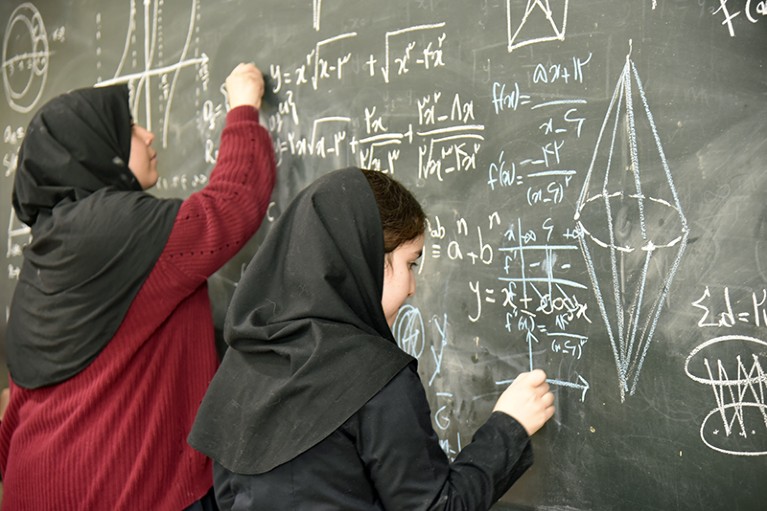
Maryam Mirzakhani made breakthroughs in fields such as dynamics.Credit: The Simons Foundation
Secrets of the Surface Director: George Csicsery Zala Films (2020) http://www.zalafilms.com/secrets
Maryam Mirzakhani broke into the exclusive club of top mathematics prizewinners in 2014. It was a momentous occasion: whether because of committee biases or the gauntlet of systemic obstacles and social pressures, no woman had previously won the discipline’s most coveted award, the Fields Medal, established in 1936. Now, it seemed that the pipeline of female talent was finally beginning to deliver.
George Csicsery’s Secrets of the Surface is the first feature-length film on Mirzakhani. It celebrates how she broke multiple glass ceilings — she was also the first Iranian to win the prize. And it strikes a satisfying balance between her magnificent mathematics and her human story, including her untimely death from cancer in 2017, at the age of 40.
The film traces Mirzakhani’s roots and legacy, interviewing current students and teachers at the school for intellectually gifted girls she attended in Tehran. She did not show a particular interest in maths early on. Instead, she devoured books, dreaming of becoming a writer. But her aptitude for numbers showed: classmates joked that when presented with a problem in a maths lesson, she took pleasure in solving it four different ways.
Inspirational performance
In 1994, Mirzakhani and her best friend, Roya Beheshti — now a mathematician at Washington University in St. Louis, Missouri — became the first women in the Iranian delegation to the International Mathematical Olympiad. Mirzakhani returned the next year, and gained a perfect score. Her exceptional performance made her a national celebrity, and inspired other Iranian girls to study mathematics.

Iranian girls were inspired to take up mathematics as a result of Maryam Mirzakhani’s success.Credit: George Csicsery
Graduating from Sharif University of Technology in Tehran, she went on to study for a PhD at Harvard University in Cambridge, Massachusetts. (A move that would these days be extremely difficult, given US President Donald Trump’s restrictions on travel to the United States from Iran and other countries.) In her thesis, Mirzakhani solved a central problem about curves on Riemann surfaces, a subject with a 150-year pedigree. To describe this and other achievements, the documentary switches from biographical to educational mode, with elegant animations.
Billiard-ball breakthrough
Soon after her earning her PhD, Mirzakhani became a faculty member at Stanford University in California, where she made several other breakthroughs with various collaborators. In one major result, she and Alex Eskin of the University of Chicago in Illinois studied the chaotic dynamics of billiard balls.
In the film, many collaborators and peers describe a problem solver with the indomitable spirit of a marathon runner. Some fight back tears as they recall working alongside her. Their accounts are greatly enriched by interviews and other footage of Mirzakhani shot for a series of videos on the four winners of the 2014 Fields Medals.
Csicsery has carved a niche as a maker of compelling films about mathematicians, starting with the brilliant 1993 N is a Number, on Paul Erdős, the most productive mathematician of the modern era and a perennial couchsurfer. Csicsery’s latest work celebrates the importance of female role models by showing the impact of Mirzakhani’s short but extraordinary life on today’s young women. But it never directly addresses the big question: why has no other woman ever won a Fields Medal (and only one, Karen Uhlenbeck in 2019, has received the Abel Prize), and what can be done to change this?

 The Fields Medal should return to its roots
The Fields Medal should return to its roots
 Maryam Mirzakhani (1977–2017)
Maryam Mirzakhani (1977–2017)
 Soap-bubble pioneer is first woman to win prestigious maths prize
Soap-bubble pioneer is first woman to win prestigious maths prize
 Celebrate the mathematics of Emmy Noether
Celebrate the mathematics of Emmy Noether





